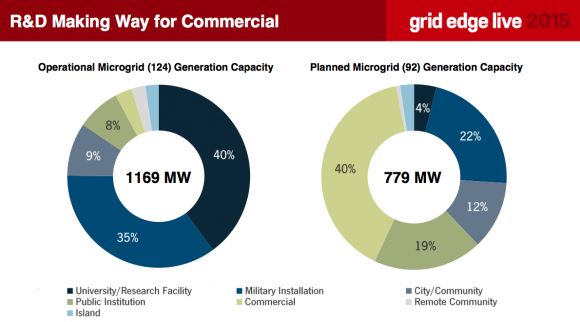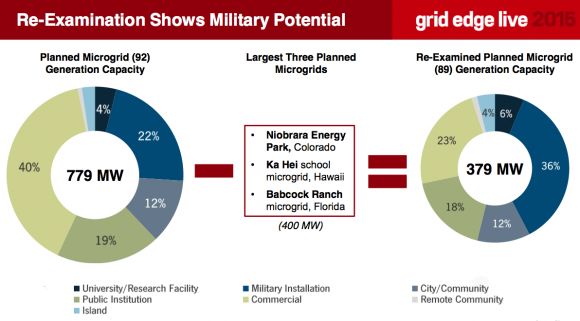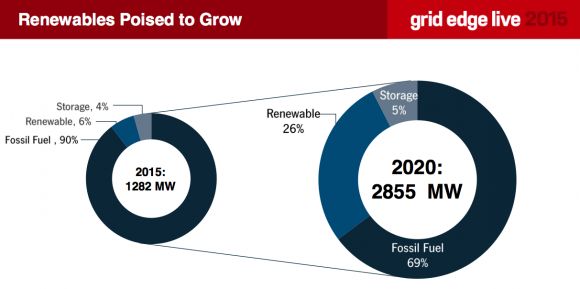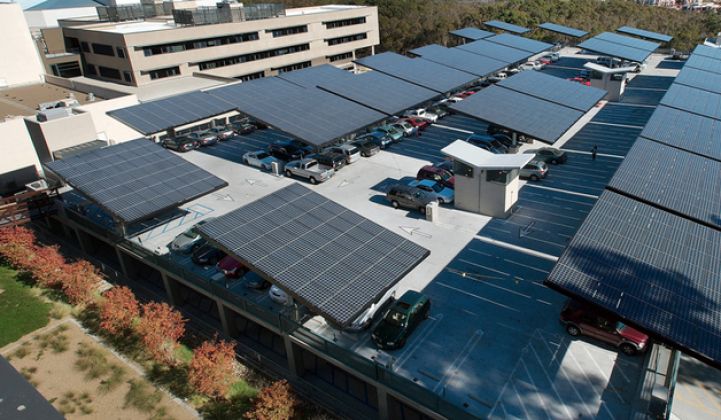A decade ago, microgrids were mostly the subject of academic research papers. Today, they are becoming a reality.
Over the next five years, the cumulative operational capacity of microgrids in the U.S. is expected to more than double, from 1,283 megawatts in 2015 to 2,855 megawatts by 2020, according to the latest figures from GTM Research. Total microgrid market value over this period is expected to exceed $3.5 billion.
“This trend signals a shift toward increasing commercial viability,” said Omar Saadeh, GTM senior analyst, who kicked off the Grid Edge Live microgrid pre-conference today in San Diego.
“As the price of energy storage drops, the price of integrating renewables becomes substantially lower and the technology continues to mature -- which will be happening over the next few years. We expect far greater adoption of microgrids by communities and corporations looking for electricity reliability,” he said.

The U.S. military has invested heavily to develop the technological capabilities of microgrids in recent years, viewing the independently operable grids as a way to maintain mission-critical loads and reduce energy use. Universities, such as UC San Diego, have also been early leaders in microgrid development.
Large institutions will continue to make up the majority of new microgrid capacity. However, the market is becoming more diverse. Microgrids are now gaining traction among commercial customers as technologies located at the grid edge continue to get cheaper and the overall economic case improves.
Commercial and industrial customers are likely to be first adopters in the commercial space, because they tend to have large facilities with dense populations during the day and place a high value on uninterrupted operations. These customers are currently slated to make up 40 percent of planned microgrid generation capacity.

Taking a more conservative approach by subtracting the three largest microgrids in development (Niobrara Energy Park, Colorado; Ka Hei school microgrid, Hawaii; and Babcock Ranch microgrid, Florida), commercial microgrid generation capacity falls to 23 percent, but continues to make up a sizable chunk of the market.

While large customers will continue to dominate the market in terms of capacity, Saadeh noted that there are a significant number of smaller microgrids under 1 megawatt, which currently account for half of all microgrids in operation in the U.S.
These projects are designed to support cities, communities and critical infrastructure, such as hospitals or community shelters, as opposed to larger microgrids that are designed to keep a commercial campus running during a power outage.
Most of the community-oriented projects on-line or in the pipeline are being driven by state incentives. This is particularly true in the Northeast where several state governments launched initiatives around resiliency following wide-scale outages triggered by Hurricane Irene and Superstorm Sandy.

As microgrids continue to gain traction in different customer segments, they will also become more diverse in terms of generation.
Today, fossil fuels make up 90 percent of existing microgrid capacity, while renewables account for just 6 percent. Looking out to 2020, the share of renewables, led by solar, will more than quadruple as microgrids emerge as an attractive option for renewable energy integration all across the country.
“We have this concept of microgrids being a great distributed energy resource integration platform, which they are. But today, renewables only make up a small portion of cumulative microgrid capacity, mainly due to large CHP-originated projects in the Northeast and diesel generator deployments in remote and island communities, or even in military applications,” said Saadeh.
“But we project the value proposition of integrating renewables to rapidly increase,” he continued. “By 2020, we expect renewable generation to make up 26 percent of overall microgrid capacity.”

Market trends presented at the Grid Edge Live pre-conference will be explored in greater detail in the upcoming GTM Research report, North American Microgrids 2015.



